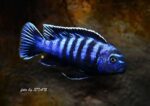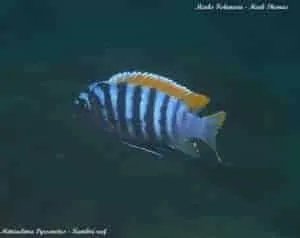Chindongo saulosi
Chindongo saulosi is a dwarf cichlid from Lake Malawi and was discovered by accident during an expedition by Ad Konings in 1989. While diving at the Taiwan Reef, he had to wait a while to clear his ears when he saw a large group of bright yellow fish swimming in the strong current around the reef.
The species is named by Konings after Saulos Mwale, head of the diving team of Stuart Grant, who was the first to succeed in bringing the Chindongo saulosi up despite the strong current. This is probably the Malawi cichlid with the smallest distribution area, it is only found on Taiwan Reef. The Chindongo family name is the local name for small rock-dwelling fish.
Stuart Grant immediately realized that this would be a highly sought-after species. To prevent that he himself would be left empty-handed and the European breeders would sell the offspring for a lot of money with just a few wild-caught animals, he tried to mass-breed the Chindongo saulosi. He only partially succeeded. No matter how stupid it may sound, breeding in Malawi itself is not that simple. Electricity is scarce and expensive and at night it often becomes too cold to keep the breeding basins at the right temperature. On windy days, the water is too cloudy to continuously pump water out of the lake, so that is not an option either. He eventually shipped larger numbers but not in the quantities that were hoped.
Because research into the distribution of species within the Malawi cichlids has taken a while, he was initially assigned to the genus Pseudotropheus: Pseudotropheus saulosi. After a major re-description, the division of this genus started and they were assigned to the genus Chindongo.
Description
All Chindongo saulosi start with the female colors, that is yellow. Once sexually mature, the dominant males slowly change color. They get a light blue base color with dark blue to black vertical stripes on top.
This is a relatively peaceful Mbuna that is not too aggressive. The males will defend a small territory if there are females to mate with, but otherwise they leave other species alone. Chindongo saulosi is very easy to keep in a group, make sure you have more females than males.
Biotope
In the wild Chindongo saulosi occurs at a depth of 7 to 15 meters. The females and males without their own territory form schools of yellow fish, sometimes as many as 50 specimens, grazing among the algae. Only the males with their own territory turn completely blue. Relatively speaking, there are only a few fully colored men per school. The blue color indicates that he has obtained a good spawning place. The male will probably not leave this territory. This territory is usually located around a rock and measures around 2 by 2 meters.
Breeding Chindongo saulosi
Like almost all Malawi cichlids, the female hatches the eggs in the mouth. The nests are not large, a maximum of 20 eggs but 10 to 15 eggs are more common. After brooding for 13 to 18 days, the female spits out the fry, after which they have to take care of themselves. Chindongo saulosi is a real herbivore, so a vegetarian diet keeps them healthy. Occasionally some mysis, krill or artemia won’t hurt.
Conclusion
Due to its maximum size of 8 to 10 centimeters, Chindongo saulosi is counted among the dwarf cichlids. The males, however, react very aggressively to other blue-striped fish; even though they are larger. You can therefore better avoid this combination. The combination of a blue male with a yellow female makes this a real eye-catcher in your aquarium!
Video
Author
John de Lange
Copyright images
Kevin Bauman
Stanisław Gajaszek

















Reviews
There are no reviews yet.